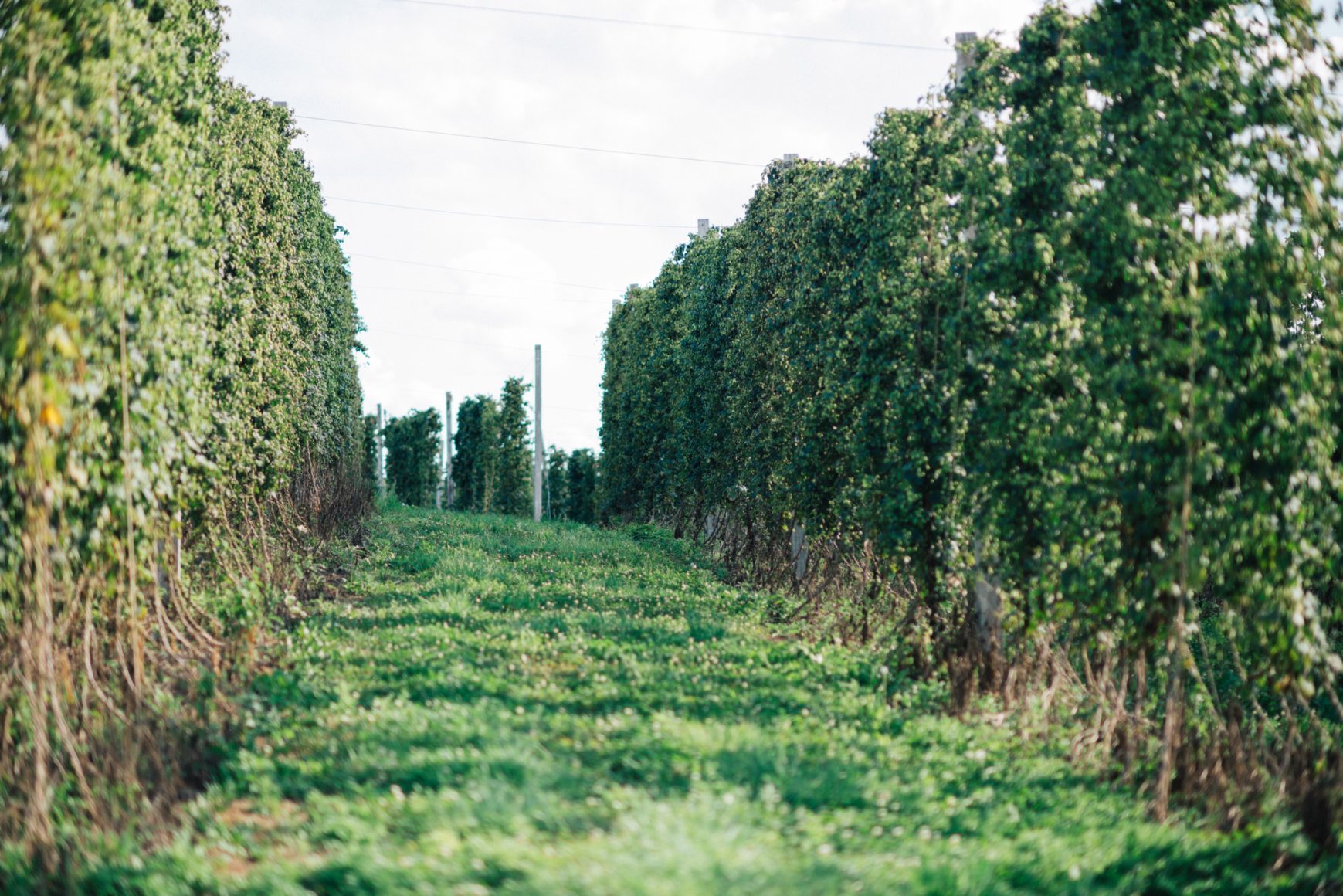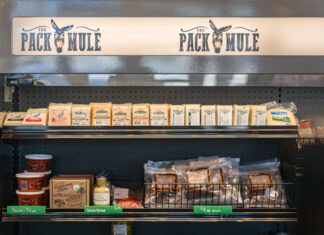Farm-to-plate is a concept many of us are familiar with – fresh food, harvested at its peak, sourced transparently, and prepared in a way that honors the ingredients. It’s an exciting way to eat, and by definition, it’s a unique culinary experience each time. One farm in Valley Springs, however, has taken that concept in another direction – field-to-glass.

A Homestead Brew invites guests to see every step of the beer-making process – starting with fragrant, green hops (the main flavoring ingredient in beer) and ending with a tasty, fermented beverage. Husband and wife owners Lee Anderson and Janelle “Nelligh” Johnson want their guests to leave with more than a commemorative hat.
“We would like to provide a really tranquil experience,” said Anderson. “Being out on the farm, in the middle of nowhere provides that. It’s amazing, being able to walk out to specific areas of the farm and say, ‘You know what? These plants made our Dandy or our Mulberry Sour.”

For Anderson, this field-to-glass experience is the culmination of a 15-year dream. He and Johnson both grew up in Sioux Falls, but Anderson’s family farmstead just east of town has long captured his imagination. As a student at Lincoln High School, then while studying applied sciences at Le Cordon Bleu, he believed that piece of land would play an important role in his family’s future, and bring him a satisfying level of professional independence.
In 2012, everything began falling into place. That was the year the couple brewed their first beer from a kit – and the year they planted their first 2,000 hop bines on the Valley Springs farm. The bines are stout and vine-like, growing vertically on trellises – a process that begins with training the plants to wrap in a semi-orderly clockwise fashion, and begins again each spring. After a couple of seasons, and a lot of careful hand pruning, good quality hops began to grow in earnest.

Hops may not seem like a traditional South Dakota crop, but historically, farmers grew them throughout the state. Anderson explains that hops were popular in the early years of statehood, but during Prohibition, they were no longer profitable and farmers ripped them all out. This is why wild hops are sometimes found throughout the southeast corner of South Dakota, near Vermillion and Yankton. And while hops can grow in most climates, Anderson believes the good quality of the soil here leads his hops to grow especially well.
“South Dakota hops grow bigger than usual,” he said. “I believe it’s our soil depth and soil saturation levels. Our Chinook grows almost a four-inch cone, and it’s a very big producer.”
Anderson adds that as far as flavor goes, like wine, terroir – or the complete natural growing environment – affects the overall character of a beer.

“The difference has a lot to do with the type of nutrients we’re using, what kind of sun we saw that year, how we’re keeping up on watering,” he explained.
Anderson and Johnson started by planting popular Chinook and Nugget varieties, and over time, expanded their repertoire to include Cascade, Centennial, and Perle hops, as well. Each variety was selected based on flavor profile – some bringing citrusy notes, while others are more floral, earthy, or nutty. Now at six acres and more than 10,000 bines, the Anderson Hop Farm is the largest producer in South Dakota, selling hops to other local breweries, including Miner Brewing Company, Spearfish Brewing Company and Crow Peak Brewing Company, which used them to brew the popular 605 Harvest Ale.

Nowadays, however, most of the hops are kept on the farm, because in 2017, Anderson and Johnson celebrated the opening of an on-site taproom. The taproom has a viewing window, so visitors can see how hops are processed from cone to pellet. Beer-in-hand, guests can also enjoy views of the modern brew house and the original family homestead. That family heritage narrative is a cornerstone of A Homestead Brew’s branding, extending inside the newly-built taproom, as well.
“We were very lucky to be able to use original barn wood off the claim shack my grandpa was born in,” said Anderson. “All our tables in the taproom are the floor out of the house. It is very important to show our passion for taking care of the land. Recycle, reuse, and repurpose for the next generation.”

On most days, visitors can choose from 10 different beers. This includes A Homestead Brew’s four flagships: Farmhouse Sour, Bicentennial IPA, Amber Waves Amber Ale, and The Tycoon Wheat Ale. The other six taps feature a rotation of seasonal beers. Anderson enjoys creating interesting, unique, tasty beers – including barrel-aged brews and living sour beers.
“These beers are naturally probiotic and high in antioxidants,” he explained. “They take us six-plus months to age. They produce complex flavor profiles that are different from a kettle sour or a gose. Those are pasteurized, while ours are living beers.”

Anderson and Johnson also enjoy bringing their guests on tours of their farm and facilities, allowing them to see the brewing process all the way through. When the weather is good, they can walk among the trellises and see the hops growing, then look at the specialty machines used to pick the cones and turn them into easy-to-use pellets, before visiting the brew room.
Anderson’s enthusiasm has certainly propelled the project, but he’s quick to point out that Johnson’s attention to detail has been invaluable to the operation. Anderson calls her the “brains,” explaining that as a practicing paralegal, she has a gift for crossing her t’s and dotting her i’s. She was instrumental in getting the farm rezoned as an agricultural tourism site, which sets precedent for other hop producers looking to provide a similar experience. She also handles licensing for the brewery, filing paperwork, and making sure all fees are paid – in addition to helping with brewing, growing hops, and working her fulltime job. Add in the couple’s three kids, and it’s a busy life – but it’s also a true partnership.

The taproom is currently open only on Saturdays to accommodate Anderson and Johnson’s myriad family and professional obligations. However, those wishing to take a tour or stop out on other days can call and make an appointment. A Homestead Brew is also accepting event bookings, including weddings, company picnics, and disc golf tournaments.
And while they’re admittedly still at the ground floor, Anderson knows that they’re on the right track. He has already started consulting for other farmers who are interested in growing hops, and in 2018, A Homestead Brew will have beers featured at six different beer dinner events throughout the state.

Someday, the couple would like to have a farm-to-plate restaurant, too, with food made to pair with their beers – but according to Anderson, right now is about putting one foot in front of the other and doing what they do well. Nevertheless, he says, “There’s a lot we still want to do, and it’s the kind of thing I dream about when we’re out in the field, watching the birds.”
For more info, visit ahomesteadbrew.com.
ALL ABOUT HOPS
- The first documented use of hops in beer was in 9th Century Germany.
- Hops are used for their antibacterial qualities in brewing – not just their flavor.
- The first hops were grown in 1629 in the American colonies by English and Dutch settlers.
- Hops are used in herbal medicine to treat anxiety, restlessness, and insomnia.
- Young hop shoots are edible and can be prepared like asparagus.
A HOMESTEAD BREW HOPS VARIETIES
Chinook
Characteristics
Pine, resin, spice, citrus
Styles
American IPA, American Pale Ale, American Brown Ale
Nugget
Characteristics
Wood, resin, spice
Styles
Ale, Stout, Barleywine
Cascade
Characteristics
Floral, citrus, spice
Styles
American Pale Ale, Lager
Centennial
Characteristics
Citrus, earth, floral
Styles
Ale, IPA, Wheat Beers
Perle
Characteristics
Herbal, spice, floral, mint
Styles
Kölsch, Lager, Pilsner

















